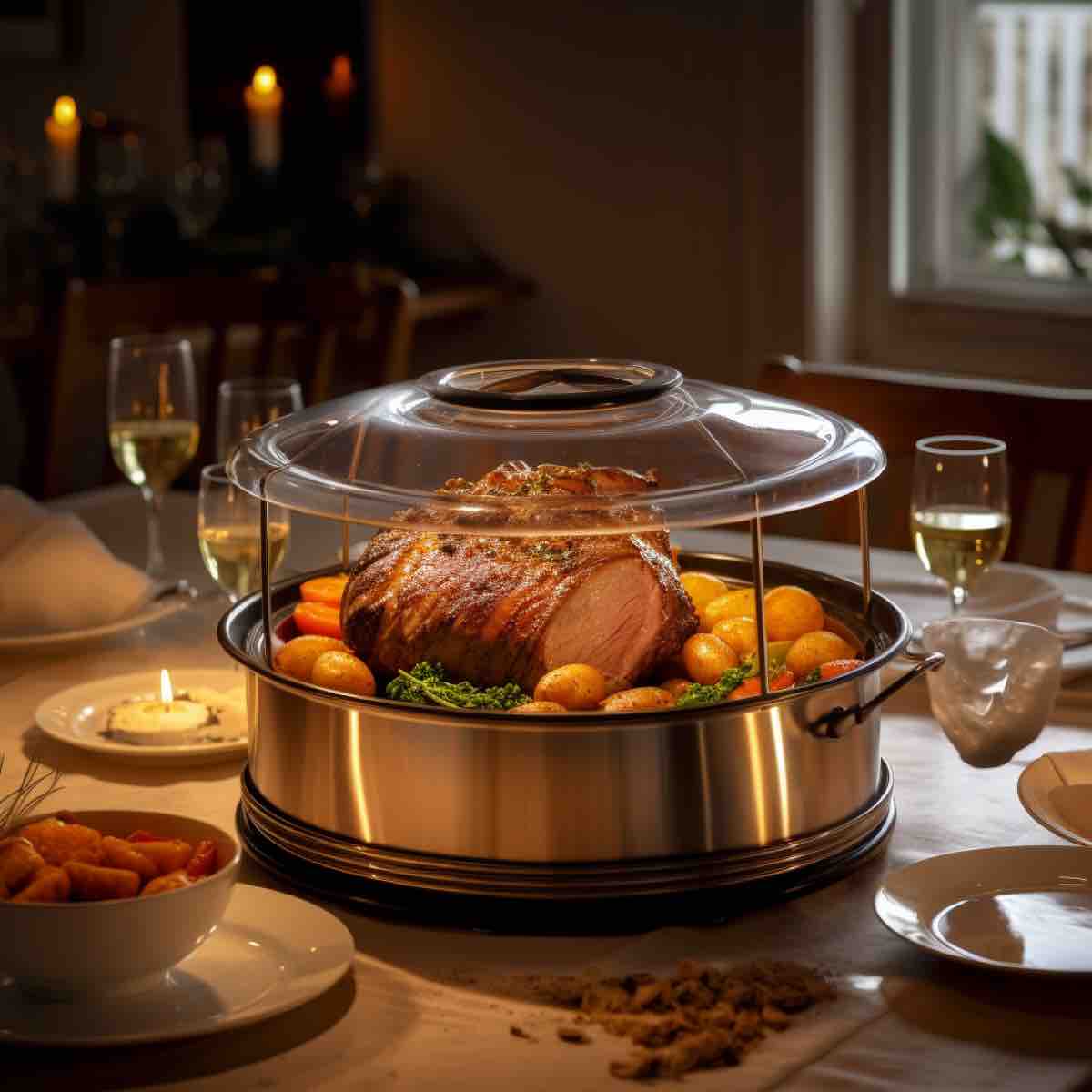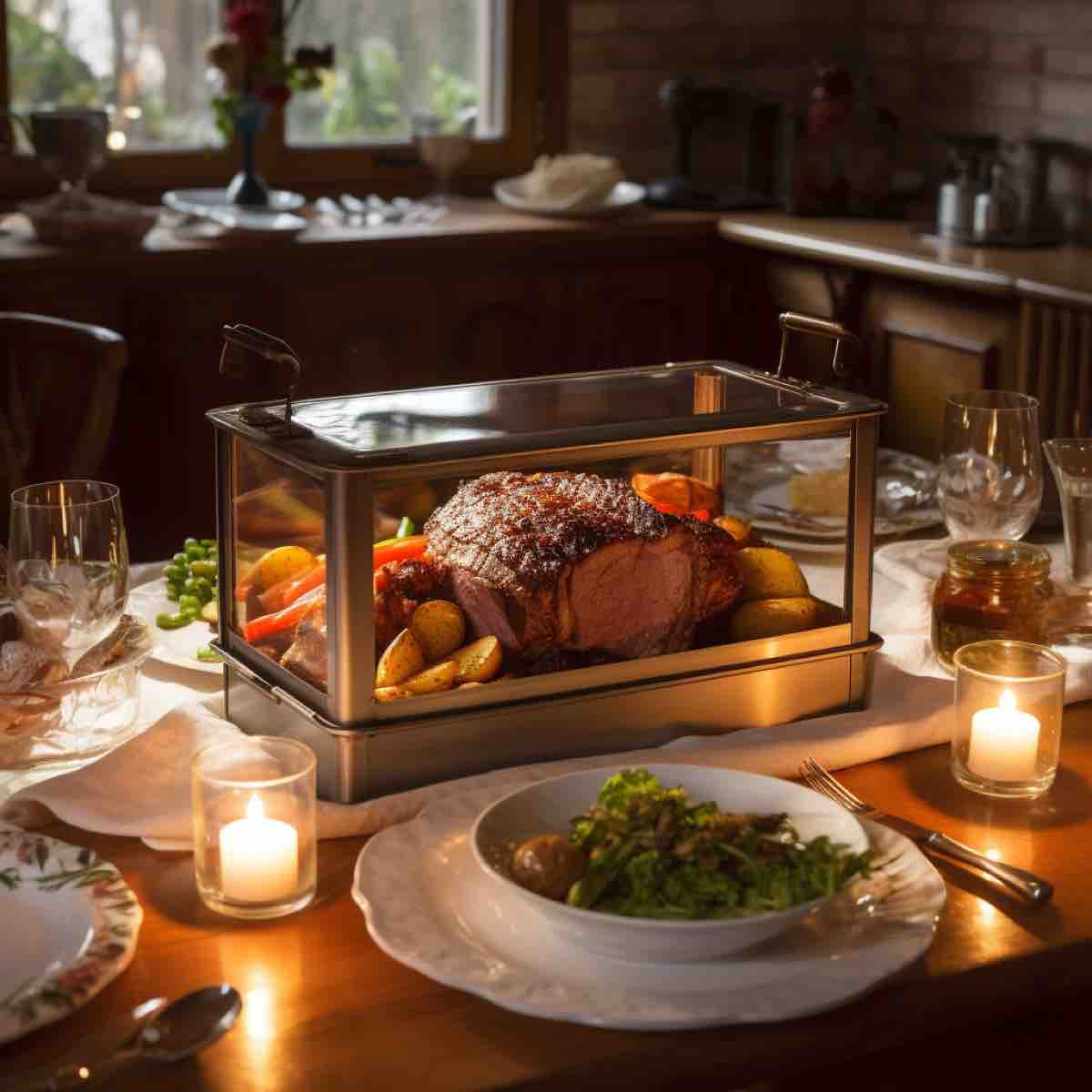A food warmer is a versatile appliance designed to keep food hot and at safe temperatures for extended periods.
They come in different types including chafing dishes, warming trays, and countertop pressure cookers, each with their unique benefits.
Preparing your food warmer involves testing settings, cleaning and sanitizing, and choosing the right dishware.
These appliances are particularly useful during events like Thanksgiving, where large quantities of food need to be kept warm for a lengthy period. It’s important to choose a food warmer based on your serving needs, the number of guests, and the types of dishes you’ll be serving.
Ensuring dishes remain at their optimal temperature allows for a more enjoyable and safe dining experience.
Benefits of Using a Food Warmer for Thanksgiving Dinner
Using a food warmer is an efficient and safe way to keep your Thanksgiving dinner warm and ready for serving.
Keeping food at a safe temperature is crucial to prevent the growth of harmful bacteria and ensure that your guests can enjoy the meal without any concerns.
Additionally, using a food warmer can also make the serving process more efficient and enjoyable as you won’t have to worry about constantly reheating individual dishes.
Plus, I find people enjoy and eat more when they have hot food.

There are different types of food warmers available, each with its own set of benefits and features.
Chafing dishes are a popular option, especially for large gatherings, as they have ample storage space and offer an elegant display.
Warming trays are ideal for keeping dishes warm for an extended period of time and come in various sizes to accommodate different serving needs.
Countertop pressure cookers are perfect for cooking and keeping rice, stews, or even chicken stock warm.
Overall, using a food warmer is an obvious solution to the challenging task of keeping food hot and safe during Thanksgiving dinner.
By choosing the right type of food warmer, you can ensure that your dishes remain at their optimal temperature and are ready to be enjoyed by your guests.
Preparation Before the Meal
Preparing the meal and planning how to use the food warer is important.
Here are some steps you can take to prepare your food warmer before the big day:
1. Test the settings: Make sure to test the different settings of your food warmer ahead of time. This will help you to understand how long it takes to heat up, how hot it gets, and how long it can keep food warm without overcooking it.
2. Clean and sanitize: Food safety is extremely important, so make sure to clean and sanitize your food warmer before using it. This will help to remove any bacteria or dirt that may have accumulated during storage. Cleaning chafing dishes is important as their large surface area collects dust.
3. Choose the right dishware: Not all dishes are suitable for use with a food warmer. Avoid using plastic or thin glass dishes, which may crack or melt under high heat. Instead, opt for oven-safe plates or stainless steel containers that can withstand high temperatures.
Types of Food Warmers
There are many different types of food warmers. Buffet warmers are the perfect choice for large gatherings where several dishes need to be kept warm at the same time. They come in different sizes and shapes to accommodate different types of dishes.
Buffet warmers come with multiple compartments, making it easy to keep different dishes warm at the same time.
Chafing dishes, on the other hand, are ideal for formal events, keeping food hot while also adding to the display and aesthetic of the event.
Heat lamps are also available, providing heat from above, making them ideal for dishes that require a crisp finish, such as roasted meats or vegetables.

Choosing the Right Food Warmer
For larger gatherings, chafing dishes are ideal as they can keep larger quantities of food warm for extended periods.
They also come in different sizes and styles, so it’s important to choose one that matches the overall aesthetic of your dinner. If you’re hosting a more intimate sit-down dinner, a warming tray may be a better option as it can keep several dishes warm on one surface and is more compact.
Slow cookers are another popular choice for keeping food warm thanks to their low and steady heat. They’re great for keeping moist dishes like stews and soups warm for longer periods and can be a lifesaver for hosts running out of oven space.
When choosing a food warmer, consider the types of dishes you are serving and the number of guests you are hosting. It’s important to also consider the available space and how the food warmer will fit in with the rest of your dinner setup.
With the right food warmer, you can ensure that your guests enjoy a warm and safe Thanksgiving meal.
Preparing Your Dishes for Warming
1. Reheating Dishes: Start by reheating your dishes in the oven at the lowest temperature possible. You want to avoid overheating or burning the food. Also you do not want to dry it out so keep a food thermometer handy and check the internal temperature regularly.
2. Warm Serving Plates: To keep your serving plates warm, place them in the oven at 200°F for 10-15 minutes before serving. Alternatively, you can fill a sink or large bowl with hot water and place the plates in it for a few minutes.
3. Chafing Dishes and Warming Trays: When using chafing dishes, fill the bottom with boiling water and place the metal dish on top. This will create indirect heat and help keep your food warm without drying it out. For warming trays, choose metal dishes that can absorb and retain heat well.
Using metal dishes is another good tip as they absorb and retain heat better than other materials like glass or plastic. This means your food stays warm for a longer period and at a safe temperature. With these simple steps, you can ensure your Thanksgiving dinner is a success and your guests leave happy and satisfied.
Keeping the Food Warm During Cooking and Serving
Keeping the food warm during cooking and serving is an essential aspect of any successful holiday meal. With so many dishes to prepare, it can be challenging to ensure that everything stays at the optimal temperature.
Setting Up the Food Warmer Ahead of Time
Setting up the food warmer ahead of time is essential in keeping your Thanksgiving dinner warm and delicious. The type of food warmer to use will depend on your chosen dishes, but the most common options are warming trays or chafing dishes.
Before beginning to cook, ensure that you have enough warmers or dishes to keep the food in and preheat the storage containers. Preheating the storage containers will help maintain the optimal temperature and ensure the food stays at a safe temperature.
To prep the warmers, plug them in and turn them on at the lowest temperature. It’s important to note that some warmers may take longer to preheat than others, so be sure to give enough time for them to warm up.
Once preheated, carefully place the dishes or food in the warmed storage container and adjust the temperature as necessary. If using a chafing dish, fill the bottom tray with boiling water to provide indirect heat and keep the food hot.
With a little planning and preparation, setting up the food warmer ahead of time will make keeping your dishes warm during Thanksgiving dinner a breeze.
Keeping Hot Foods Hot During Cooking and Serving
Maintaining hot foods at a safe temperature is vital to prevent foodborne illnesses.
Here are several methods you can use to keep your hot food warm during cooking and serving:
1. Chafing dishes: Chafing dishes are a classic way to keep large quantities of food warm during serving. They incorporate a water pan and a fuel source to provide continuous indirect heat. The steam created from the water pan helps to keep the food moist and prevents it from drying out.
2. Warming trays: These are electric appliances that are ideal for keeping smaller quantities of food warm during serving. They incorporate a heating element beneath a metal surface that evenly distributes heat and maintains the food’s temperature.
3. Slow cookers: Slow cookers are great for preparing and serving warm dishes during a party or gathering. They use low heat to slowly cook and keep the food warm without drying it out.
4. Indirect heat: Indirect heat sources like boiling water or oven drawers can be used to keep plates and bread warm during serving. Simply place plates or bread in an oven drawer or cover them with foil and place them on a rack above a pan of boiling water.
5. Heat Lamps. Heat lamps, often used in professional kitchens and catering services, are a type of food warmer that keeps food at a safe and enjoyable temperature by providing direct, overhead heat. Heat lamps are particularly suitable for dishes that require a crisp finish, such as roasted meats or vegetables. They allow food to stay warm for extended periods, ensuring that it’s ready to serve whenever needed, and contribute to food safety by maintaining temperatures above the point where harmful bacteria can grow.
By using these methods and keeping your hot food at a safe temperature, you can ensure your guests enjoy a delicious and safe meal.
Keeping Cold Foods Chilled During Cooking and Serving
It’s important to keep cold foods properly chilled during cooking and serving to prevent the growth of harmful bacteria that can cause foodborne illnesses. One effective method is to use ice-filled bowls or trays to keep salads and dips at a safe temperature. Alternatively, you can keep cold foods in an insulated cooler or incorporate frozen fruits or vegetables into salads to maintain an optimal temperature.
Conclusion
In conclusion, ensuring that your Thanksgiving dinner stays at safe temperatures is crucial for the success of your meal. Throughout this article, we have discussed various ways to keep your food hot and safe for consumption, such as using food warmers, chafing dishes, baking sheets, and even slow cookers. It is important to remember that proper preparation is key, from selecting the right containers for storage to keeping track of the length of storage for each item.
By following these guidelines, you can ensure that your guests will enjoy their meal without any worries about cold or undercooked food. Thanksgiving is a time to gather with friends and family, and by prioritizing food safety, you can make the occasion even more special. So, keep these tips in mind and have a safe and successful Thanksgiving!